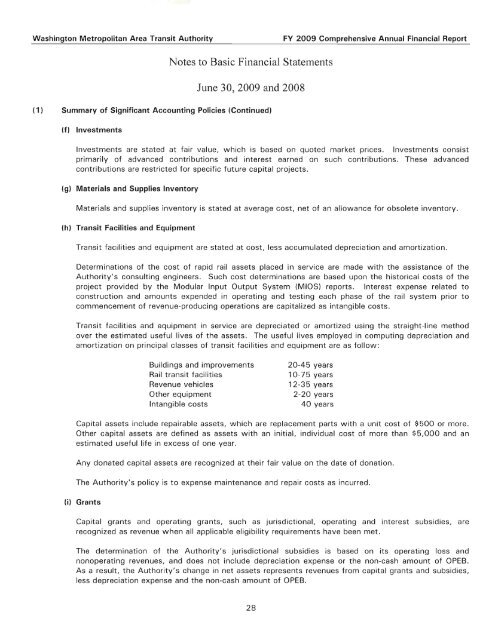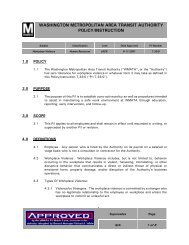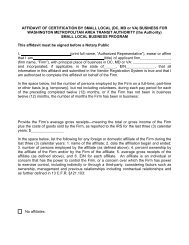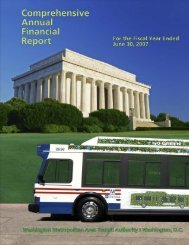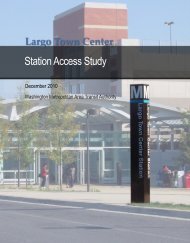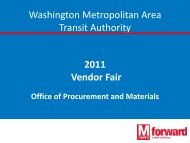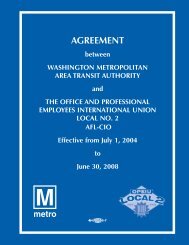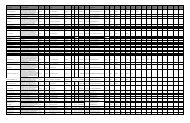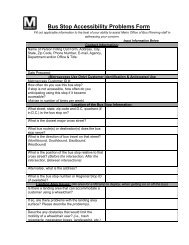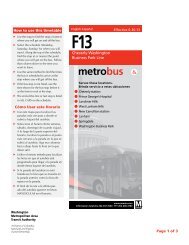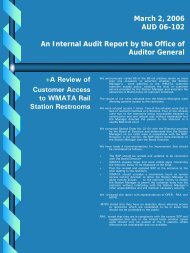Comprehensive Annual Financial Report for the ... - WMATA.com
Comprehensive Annual Financial Report for the ... - WMATA.com
Comprehensive Annual Financial Report for the ... - WMATA.com
- No tags were found...
Create successful ePaper yourself
Turn your PDF publications into a flip-book with our unique Google optimized e-Paper software.
Washington Metropolitan Area Transit AuthorityFY 2009 <strong>Comprehensive</strong> <strong>Annual</strong> <strong>Financial</strong> <strong>Report</strong>Notes to Basic <strong>Financial</strong> StatementsJune 30, 2009 and 2008(1) Summary of Significant Accounting Policies (Continued)(f)InvestmentsInvestments are stated at fair value, which is based on quoted market prices. Investments consistprimarily of advanced contributions and interest earned on such contributions. These advancedcontributions are restricted <strong>for</strong> specific future capital projects.(g) Materials and Supplies InventoryMaterials and supplies inventory is stated at average cost, net of an allowance <strong>for</strong> obsolete inventory.(h) Transit Facilities and EquipmentTransit facilities and equipment are stated at cost, less accumulated depreciation and amortization.Determinations of <strong>the</strong> cost of rapid rail assets placed in service are made with <strong>the</strong> assistance of <strong>the</strong>Authority's consulting engineers. Such cost determinations are based upon <strong>the</strong> historical costs of <strong>the</strong>project provided by <strong>the</strong> Modular Input Output System (MiaS) reports. Interest expense related toconstruction and amounts expended in operating and testing each phase of <strong>the</strong> rail system prior to<strong>com</strong>mencement of revenue-producing operations are capitalized as intangible costs.Transit facilities and equipment in service are depreciated or amortized using <strong>the</strong> straight-line methodover <strong>the</strong> estimated useful lives of <strong>the</strong> assets. The useful lives employed in <strong>com</strong>puting depreciation andamortization on principal classes of transit facilities and equipment are as follow:Buildings and improvementsRail transit facilitiesRevenue vehiclesO<strong>the</strong>r equipmentIntangible costs20-45 years10-75 years12-35 years2-20 years40 yearsCapital assets include repairable assets, which are replacement parts with a unit cost of $500 or more.O<strong>the</strong>r capital assets are defined as assets with an initial, individual cost of more than $5,000 and anestimated useful life in excess of one year.Any donated capital assets are recognized at <strong>the</strong>ir fair value on <strong>the</strong> date of donation.The Authority's policy is to expense maintenance and repair costs as incurred.(i)GrantsCapital grants and operating grants, such as jurisdictional, operating and interest subsidies, arerecognized as revenue when all applicable eligibility requirements have been met.The determination of <strong>the</strong> Authority's jurisdictional subsidies is based on its operating loss andnonoperating revenues, and does not include depreciation expense or <strong>the</strong> non-cash amount of OPEB.As a result, <strong>the</strong> Authority's change in net assets represents revenues from capital grants and subsidies,less depreciation expense and <strong>the</strong> non-cash amount of OPEB.28


